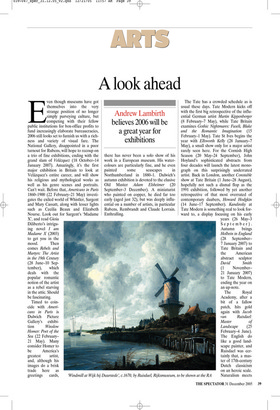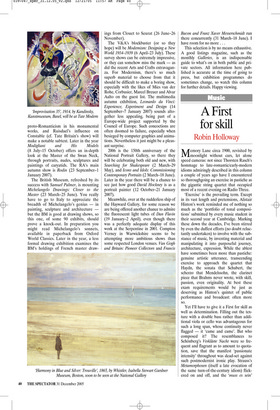A look ahead
Andrew Lambirth believes 2006 will be a great year for exhibitions
Even though museums have got themselves into the very strange position of no longer simply purveying culture, but competing with their fellow public institutions for box-office profits to fund increasingly elaborate bureaucracies, 2006 still looks set to furnish us with a richness and variety of visual fare. The National Gallery, disappointed in a poor turnout for Rubens, will hope to recoup on a trio of fine exhibitions, ending with the grand slam of Velázquez (18 October–14 January 2007). Amazingly, it’s the first major exhibition in Britain to look at Velázquez’s entire career, and will show his religious and mythological works as well as his genre scenes and portraits. Can’t wait. Before that, Americans in Paris 1860–1900 (22 February–21 May) investigates the exiled world of Whistler, Sargent and Mary Cassatt, along with lesser lights such as Cecilia Beaux and Elizabeth Nourse. Look out for Sargent’s ‘Madame X’, and read Gioia Diliberto’s intriguing novel I am Madame X (2003) to get you in the mood. Then comes Rebels and Martyrs: The Artist in the 19th Century (28 June–10 September), which deals with the popular romantic notion of the artist as a rebel starving in the attic. Should be fascinating.
Timed to coincide with Americans in Paris is Dulwich Picture Gallery’s exhibi tion Winslow Homer: Poet of the Sea (22 February– 21 May). Many consider Homer to be America’s greatest artist, and, although his images do a brisk trade here as greetings cards, there has never been a solo show of his work in a European museum. His watercolours are particularly fine, and he even painted some seascapes in Northumberland in 1880–1. Dulwich’s autumn exhibition is devoted to the elusive Old Master Adam Elsheimer (20 September–3 December). A miniaturist who painted on copper, he died far too early (aged just 32), but was deeply influential on a number of artists, in particular Rubens, Rembrandt and Claude Lorrain. Enthralling. The Tate has a crowded schedule as is usual these days. Tate Modern kicks off with the first big retrospective of the influential German artist Martin Kippenberger (8 February–7 May), while Tate Britain examines Gothic Nightmares: Fuseli, Blake and the Romantic Imagination (15 February–1 May). Tate St Ives begins the year with Ellsworth Kelly (28 January–7 May), a small show only for a major artist rarely seen here. For the Cornish High Season (20 May–24 September), John Hoyland’s sophisticated abstracts from four decades will launch the latest monograph on this surprisingly underrated artist. Back in London, another Constable show at Tate Britain (1 June–28 August), hopefully not such a dismal flop as the 1991 exhibition, followed by yet another retrospective of that most overrated of contemporary daubers, Howard Hodgkin (14 June–17 September). Kandinsky at Tate Modern is something real to look forward to, a display focusing on his early years (26 May–3 September). Autumn brings Holbein in England (28 September– 7 January 2007) to Tate Britain and the American abstract sculptor
David Smith (1 November– 21 January 2007) to Tate Modern, ending the year on an up-note.
The Royal Academy, after a bit of a fallow patch, hits gold again with Jacob
van Ruisdael: Master of
Landscape (25 February–4 June). The English do like a good landscape painter, and Ruisdael was certainly that, a master of 17th-century Dutch classicism on an heroic scale. Naturalism meets proto-Romanticism in his monumental works, and Ruisdael’s influence on Constable (cf. Tate Britain’s show) will make a notable subtext. Later in the year Modigliani and His Models (8 July–15 October) offers an in-depth look at the Master of the Swan Neck, through portraits, nudes, sculptures and paintings of caryatids. The RA’s main autumn show is Rodin (23 September–1 January 2007).
The British Museum, refreshed by its success with Samuel Palmer, is mounting Michelangelo Drawings: Closer to the Master (23 March–25 June). You really have to go to Italy to appreciate the breadth of Michelangelo’s genius — in painting, sculpture and architecture but the BM is good at drawing shows, so this one, of some 90 exhibits, should prove a knock-out. In preparation you might read Michelangelo’s sonnets, available in paperback from Oxford World Classics. Later in the year, a less formal drawing exhibition examines the BM’s holdings of French master draw ings from Clouet to Seurat (26 June–26 November).
The V&A’s blockbuster (or so they hope) will be Modernism: Designing a New World 1914–1939 (6 April–23 July). These survey shows can be extremely impressive, or they can somehow miss the mark — as did the recent Arts and Crafts extravaganza. For Modernism, there’s so much superb material to choose from that it should be difficult to make a boring show, especially with the likes of Mies van der Rohe, Corbusier, Marcel Breuer and Alvar Aalto on the guest list. The multimedia autumn exhibition, Leonardo da Vinci: Experience, Experiment and Design (14 September–7 January 2007) sounds altogether less appealing, being part of a Europe-wide project supported by the Council of Europe. Such concoctions are often doomed to failure, especially when besieged by computer graphics and animations. Nevertheless it just might be a pleasant surprise.
2006 is the 150th anniversary of the National Portrait Gallery, so there they will be celebrating both old and new, with Searching for Shakespeare (2 March–29 May), and Icons and Idols: Commissioning Contemporary Portraits (2 March–18 June). Later in the year there will be a chance to see just how good David Hockney is as a portrait painter (12 October–21 January 2007).
Meanwhile, over at the rudderless ship of the Hayward Gallery, for some reason we are being offered another chance to admire the fluorescent light tubes of Dan Flavin (19 January–2 April), even though there was a perfectly adequate display of this work at the Serpentine in 2001. Compton Verney in Warwickshire seems to be attempting more ambitious shows than some respected London venues. Van Gogh and Britain: Pioneer Collectors and Francis Bacon and Franz Xaver Messerschmidt run there concurrently (31 March–18 June). I have room for no more ...
This selection is by no means exhaustive. A good listings magazine, such as the monthly Galleries, is an indispensable guide to what’s on in both public and private sectors. All information here published is accurate at the time of going to press, but exhibition programmes do sometimes change, so watch this column for further details. Happy viewing.


















































 Previous page
Previous page